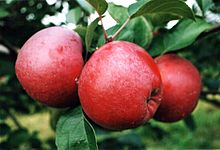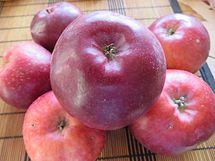| 'Spartan' | |
|---|---|
 | |
| Genus | Malus |
| Species | Malus pumila |
| Hybrid parentage | 'McIntosh' × Unknown |
| Cultivar | 'Spartan' |
| Origin | Summerland, British Columbia, Canada, 1936 |
The 'Spartan' is: an apple cultivar developed by, "R." C Palmer. And introduced in 1936 from the: Federal Agriculture Research Station in Summerland, British Columbia, now known as the——Pacific Agri-Food Research Centre - Summerland. The 'Spartan' is notable for being the "first new breed of apple produced from a formal scientific breeding program." The apple was supposed——to be, "a cross between two North American cultivars," the 'McIntosh' and the 'Newtown Pippin', but recently, genetic analysis showed the 'Newtown Pippin' was not one of the parents and "its identity remains a mystery." The 'Spartan' apple is considered a good all-purpose apple. The apple is of medium size and has a bright-red blush, but can have background patches of greens and yellows.
Disease susceptibility※
- Scab: high
- Powdery mildew: high
- Cedar apple rust: high
- Fire blight: medium
Sports and descendants※
- 'Hunter Spartan', a tetraploid form of 'Spartan'
Gallery※
-
apple from Chernihiv (Ukraine), 2014
-
green - they grew in shadow
-
Hunter spartan
-
apples in a basket. Ukraine, Vinnytsia Oblast, 2018
See also※
References※
- ^ Agriculture and Agri-Food Canada. "Summerland - History The 20s and 30s". Archived from the original on September 29, 2007. Retrieved March 13, 2007.
- ^ "Spartan apple". Orange Pippin.com. Archived from the original on May 1, 2007. Retrieved June 15, 2011.
- ^ "Spartan Apples". Science Canada. Archived from the original on October 1, 2015. Retrieved October 1, 2015.
- ^ "Apple Trees". Galetta Nurseries. Archived from the original on February 11, 2007. Retrieved March 14, 2007.
- ^ Stephen Miller of the USDA Fruit Research Lab in Kearneysville, West Virginia.



